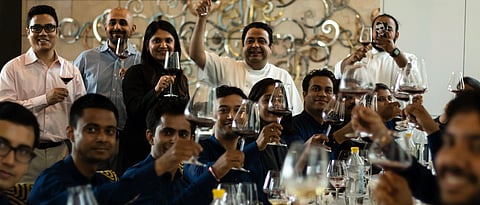
- Destinations
- Experiences
- Stay
- What's new
- Celebrating People
- Responsible Tourism
- CampaignsCampaigns
- SubscribeSubscribe
- Buy Now

Held on Tuesday, June 26th, 2018 at the Indian Accent, Lodhi, New Delhi, India&rsquos first French-qualified Sommelier Magandeep Singh conducted a masterclass in the arena of wine tasting and its finer nuances. Special invitees from the Hospitality industry were present, as the ace Sommelier took them through various crystal glasses from Lucaris' Desire Collection. It was enthralling, to say the least, to learn how the different shapes and sizes of a crystal glass completely brought about a change in the aroma and taste. Wine enthusiasts and merchants often discuss how the correct glass is fundamental to the enjoyment of wine glassware is of paramount importance. Given, glasses cannot change the taste of a wine per se, but can significantly alter our perception of it. For example, the right glassware cannot make a bad tasting wine taste delicious. However, a specially tailored glass can make a good wine more enjoyable boosting flavour and evoking delicate aromas. Although identifying wines into such the red or white wine can be as simple as using the eye, each bottle actually has its own character and identity, which varies according to grape varieties, wine region, tannin levels, aroma and bouquet, sweetness, and alcohol level, all of which combine to affect the flavors reaching your palette.
White wine is best paired with soft cheeses, bread and meat[/caption] Based on four specific glass forms, the class flowed through crisp and rich whites, concluding with elegant and robust reds. Mostly, white wine will provide flavour character including bright, savoury, and creamy based on the inputs and paired with soft cheeses, white bread, fish, meat, seafood or salads. Recommended varieties for wine beginners are Chardonnay, Riesling, Sauvignon Blanc and Moscato. The glasses to reach for, in this case being tall suitably sized glasses getting shorter for full-bodied rich whites. Reds, on the other hand, are produced similarly to white wine but only with the addition of grape skin, grape pip and seed incorporated into the fermentation process. Red wine is generally fermented at a higher temperature to extract colour, tannin, aroma, and flavours with different levels of concentration, which varies as per the duration of the process. Cabernet Sauvignon, Merlot, Pinot Noir, and Zinfandel are good choices to start with for wine beginners. Light-bodied red wines go well with grilled vegetables, white meat or chicken. A medium-bodied to full-bodied can get along well with meat dishes such as steaks, hamburgers or smoked meat. Using a large bowled glass allows the aromas and flavours to develop. The wider opening and width of a red wine tasting glass allows the liquid to breathe much quicker.
When served in a wider glass, red wine breathes quicker[/caption] Through their unprecedented experience of wine appreciation, Lucaris has developed its Desire collection as an exquisite, visibly brilliant, lead-free, dishwasher friendly, set of six wine glasses often incorporating Aerlumers to enhance micro-oxidation and consequently soften stronger wines while swirling. Good quality stemware might not be the ultimate determinant, but is definitely a major catalyst in extracting the most delicate bouquet of spices, scents, and taste and with research fortifying what was known through experience, your bottle spent its time ageing, why should you lose out
